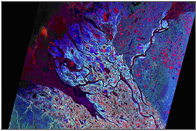|
|
|
 Blue Marble 2002: the eastern hemisphere. (Photo: NASA, Goddard Space Flight Center.)
Blue Marble 2002: the eastern hemisphere. (Photo: NASA, Goddard Space Flight Center.)
|
Tsunami in Southern Asia
After the tsunami hit southern Asia, the International Charter “Space and Major
Disasters” was activated on three occasions. Canada
participates in the Charter. Twenty-four RADARSAT-1 images were made available to stakeholders.
The image of Banda Aceh, right, is an example of the images provided. Dendron Resource Surveys
compiled data acquired by RADARSAT-1 and the Indian Remote Sensing (IRS) optical satellite.
Water, in blue, was mapped using a 2004 RADARSAT image; the pre-tsunami coastline was
established using an archived 1998 RADARSAT image. More images are available on the Charter Web site (www.disasterscharter.org) and on the CSA Web site (www.space.gc.ca).
|
|
 Banda Aceh, Northern Sumatra. RADARSAT-1 Data
Banda Aceh, Northern Sumatra. RADARSAT-1 Data
(Image: © CSA 1998 and 2004; IRS data © ISRO 2004.
|
Adapting to climate change in Canada 2005: Understanding
risks and building capacity
This conference is undoubtedly the most significant event on the impact of climate-change and
on adaptation that will be held in Canada this year.
The conference, organized by Natural Resources Canada in partnership with the Canadian Climate Impacts and Adaptation Research Network (C-CIARN), will be held in Montreal from May 4 to 7, 2005. Details on the call for abstracts
as well as the registration form are available on the Conference
website: www.adaptation2005.ca.
| |
 An image made from
images taken on many days shows the spring ice break-up in the river channels that flow through the Mackenzie Delta in the Northwest Territories.
An image made from
images taken on many days shows the spring ice break-up in the river channels that flow through the Mackenzie Delta in the Northwest Territories.
(Image: RADARSAT-1 data © CSA 1999.
|
RADARSAT-1: the Vendée-Globe Challenge
The Canadian Space Agency, owner of the RADARSAT-1 satellite along with RADARSAT International Inc. (RSI), the global leader in commercial data transmitted by RADARSAT-1, have agreed to provide the organizers of the Vendée Globe Challenge with satellite images to assist navigators in staying clear of drifting ice.
On December 28, RADARSAT-1 spotted a 400-m long iceberg. Other objects were also spotted; the probability that they were icebergs varied between 25% and 75%.
|
|
 Route of the Vendée Globe Challenge.
Route of the Vendée Globe Challenge.
|
In all cases, the Challenge director sent the analysis results to all contestants minutes after they were received. This service was so successful that other organizations have contacted the Canadian Space Agency to use this service for various other activities.
|
The Vendée Globe is one of the most respected sporting events in the sailing community. On November 7, 2004, 20 sailors set out on their sailboats for this 37,000-km solo round-the-world race, without stopovers or assistance.
Visit the following Web sites for more information:
|
|
 This RADARSAT-1 image provided by the Canadian Space Agency indicate objects
for which there is a 50% probability that they are icebergs.
This RADARSAT-1 image provided by the Canadian Space Agency indicate objects
for which there is a 50% probability that they are icebergs.
(Image: RADARSAT-1 data © CSA 2005
|
Réal Décoste Award of Excellence Program
To encourage student interest in the fields of climatology and sciences related to the impact of climate change, Ouranos has established the Réal Décoste Award of Excellence program. The
award is for $20,000 over three years, and is intended for Canadian or foreign students wishing to complete graduate studies in a Quebec university. Further information will soon be available on the Ouranos and Fonds québécois de la recherche sur la nature et les technologies (FQRNT) Web sites.
|
|
 Réal Décoste, former Director-General of Ouranos
Réal Décoste, former Director-General of Ouranos
|
Réal Décoste, who passed away on July 12, 2004, was the first Director General of Ouranos. The Ouranos Consortium,
created on May 16, 2002, pools the expertise and disciplines of numerous researchers to further knowledge of climate change and adaptation in North America.
|
|
GEO 2005 conference and Earth Observation Summit
The sixth meeting of the Group on Earth Observations (GEO) and the third Earth Observation Summit took place during Earth and Space Week in Brussels, Belgium, February
14 to 16, 2005. Earth and Space Week, also in Brussels, was February 12 to 20, 2005. This initiative of the European Commission and European Space Agency (ESA) showed how Earth observation and space improve the quality of our lives through an International Conference on Cooperation in Space, a public Earth and Space Exposition, as well as media and educational/cultural events.
Marc Garneau led the Canadian delegation and presented the accomplishments of the Canadian Group on Earth Observations. At the Earth Observation Summit in Brussels, ministers from around the world endorsed a much-anticipated 10-year plan for the creation of the Global Earth Observation System of Systems (GEOSS).
GEO was established following the Earth Observation Summit in Washington in July 2003. This initiative was led by the United States to promote the development of a comprehensive, coordinated and sustainable Earth observation system among governments and the international community. Such a system can improve our ability to understand and address environmental and economic challenges on a global scale.
For more information, see www.europa.eu.int/comm/space/esw.
|
|
